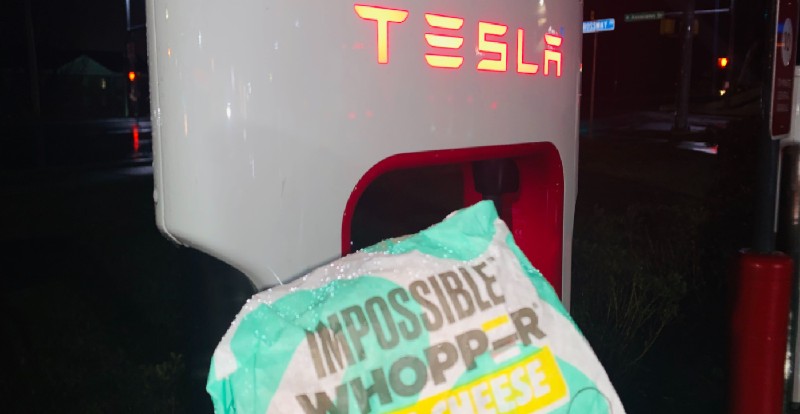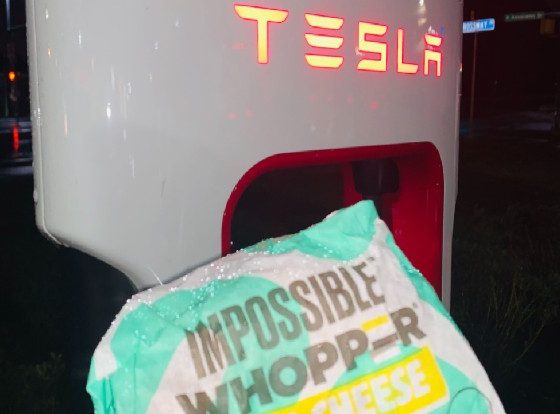

Lifestyle
Tesla’s fight for price parity is also taking shape in the sustainable food industry
Tesla’s mission for sustainability and goal to reach price parity with its petrol-powered competition in the transportation industry is also starting to take shape in the food industry. The world of meat alternatives is currently competing with animal products to achieve the same goal: price parity to promote environmental sustainability in food, an item crucial for everyday survival.
Since the release of Tesla CEO Elon Musk’s Master Plan, the goal has always been to offer affordable and environmentally sustainable options to drivers everywhere. To do this, Tesla’s ultimate goal is to drive the cost down of batteries to $100 per kWh and close the gap between the cost of electric vehicles and gas vehicles.
Similarly, meat alternatives are fighting for the same price parity in their own way. The goal of meat alternative companies like Beyond Meats and Impossible Foods is to offer options to traditional beef products at equal prices so the average consumer will consider buying sustainable and more environmentally-friendly foods that satisfy their cravings. After CNBC reported Impossible Foods’ prices were slashed by 15% earlier this week because manufacturing efficiencies and large scale production, price parity is closer than ever.
The argument against electric cars and sustainably-produced foods has always been price. As electric vehicles, Tesla’s, in particular, started expensive, they have slowly dropped in price while increasing performance and efficiency. Batteries that power the cars have become a mass-produced item, thus forcing the price of cells to drop dramatically. Eventually, this will lead to batteries being produced at the $100 kWh target, inducing price parity.
This story is no different than meat alternatives. When Beyond Meats and Impossible Foods were formed in 2009 and 2011 respectively, the goal was to create products that would give people “meat” without the adverse environmental or health effects that come from eating real beef. The battle with the new “meat” products was that they were expensive to produce; thus, many people did not see the advantage of buying them.
However, the environmental movement has grown considerably because of the increased awareness of climate change. People are now willing to cut some meat out of their diets to fight industrial farming and are replacing it with meat alternatives. As many people across the world have embraced these new meat alternatives, large scale businesses like Burger King have adapted the products because of increased demand.
Burger King added the Impossible Whopper to its menu in 2019. After prices for BK’s plant-based Whopper were noticeably higher than the company’s regular flagship sandwich, it was labeled a “premium” product. As demand for the Impossible meats rose, the cost of the went down. Now the Impossible Whopper is available on BK’s 2 for $6 menu.
The increase in demand for meat alternatives has led to lower prices. Just like electric vehicle batteries, mass production has contributed to a decrease in price, and eventually, this will lead to price parity with real meat. Beyond Meat CEO Ethan Brown predicts his company will reach price parity with natural beef products in 2024, one year after analysts believe EVs will reach parity with gas vehicles.
In the grand scheme of things, the goal between battery vehicles and meat substitutes is the same: increase environmental sustainability by offering products that are equivalent to the things people have been using for their whole lives. Turn people away from things that harm the environment and make sustainable alternatives just as affordable as their competitors, eliminating the argument that battery cars or meatless options are “too expensive” and “unaffordable.”

Lifestyle
Tesla Model S Plaid battles China’s 1500 hp monster Nurburgring monster, with surprising results
There is just something about Tesla’s tuning and refinement that makes raw specs seem not as game-changing.

The Tesla Model S Plaid has been around for some time. Today, it is no longer the world’s quickest four-door electric sedan, nor is it the most powerful. As per a recent video from motoring YouTube channel Carwow, however, it seems like the Model S Plaid is still more than a match for some of its newer and more powerful rivals.
The monster from China
The Xiaomi SU7 Ultra is nothing short of a monster. Just like the Model S Plaid, it features three motors. It also has 1,548 hp and 1,770 Nm of torque. It’s All Wheel Drive and weighs a hefty 2,360 kg. The vehicle, which costs just about the equivalent of £55,000, has been recorded setting an insane 7:04.957 at the Nurburgring, surpassing the previous record held by the Porsche Taycan Turbo GT.
For all intents and purposes, the Model S Plaid looked outgunned in Carwow’s test. The Model S Plaid is no slouch with its three motors that produce 1,020 hp and 1,420 Nm of torque. It’s also a bit lighter at 2,190 kg despite its larger size. However, as the Carwow host pointed out, the Model S Plaid holds a 7:25.231 record in the Nurburgring. Compared to the Xiaomi SU7 Ultra’s record, the Model S Plaid’s lap time is notably slower.
Real-world tests
As could be seen in Carwow’s drag races, however, Tesla’s tech wizardry with the Model S Plaid is still hard to beat. The two vehicles competed in nine races, and the older Model S Plaid actually beat its newer, more powerful counterpart from China several times. At one point in the race, the Xiaomi SU7 Ultra hit its power limit due to its battery’s temperature, but the Model S Plaid was still going strong.
The Model S Plaid was first teased five years ago, in September 2020 during Tesla’s Battery Day. Since then, cars like the Lucid Air Sapphire and the Xiaomi SU7 Ultra have been released, surpassing its specs. But just like the Model Y ended up being the better all-rounder compared to the BYD Sealion 7 and the MG IM6, there is just something about Tesla’s tuning and refinement that makes raw specs seem not as game-changing.
Check out Carwow’s Model S Plaid vs Xiaomi SU7 drag race video below.
Lifestyle
500-mile test proves why Tesla Model Y still humiliates rivals in Europe
On paper, the BYD Sealion 7 and MG IM6 promised standout capabilities against the Model Y.

BYD is seeing a lot of momentum in Europe, so much so that mainstream media has taken every opportunity to argue that the Chinese automaker has beaten Tesla in the region. But while BYD sales this year in Europe are rising and Tesla’s registrations remain challenged, the raw capabilities of vehicles like the Model Y are difficult to deny.
This was highlighted in a 500-mile challenge by What Car? magazine, which showed that the new Tesla Model Y is more efficient, cheaper to run, and more reliable than rivals like the BYD Sealion 7, and even the nearly 400 KW-charging MG IM6.
Range and charging promises
On paper, the BYD Sealion 7 and MG IM6 promised standout capabilities against the Model Y. The Sealion 7 had more estimated range and the IM6 promised significantly faster charging. When faced with real-world conditions, however, it was still the Model Y that proved superior.
During the 500-mile test, the BYD nearly failed to reach a charging stop, arriving with less range than its display projected, as noted in a CarUp report. MG fared better, but its charging speeds never reached its promised nearly-400 kW charging speed. Tesla’s Model Y, by comparison, managed energy calculations precisely and arrived at each stop without issue.
Tesla leads in areas that matter
Charging times from 25% to 80% showed that the MG was the fastest at 17 minutes, while Tesla and BYD were close at 28 and 29 minutes, respectively. Overall efficiency and cost told a different story, however. The Model Y consumed 19.4 kWh per 100 km, compared to 22.2 for MG and 23.9 for BYD. Over the full trip, Tesla’s charging costs totaled just £82 thanks to its supercharger network, far below BYD’s £130 and MG’s £119.
What Car? Magazine’s testers concluded that despite BYD’s rapid sales growth and the MG IM6’s seriously impressive charging speeds, Tesla remains the more compelling real-world choice. The Model Y just offers stability, efficiency, and a proven charging infrastructure through its Supercharging network. And as per the magazine’s hosts, the Model Y is even the cheapest car to own among the three that were tested.
Watch What Car? Magazine’s 500-mile test in the video below.
Lifestyle
Tesla Cybertruck slapped with world’s least intimidating ticket, and it’s pure cringe
One cannot help but cringe and feel second-hand embarrassment at the idea of a person just driving around with a stack of these babies.

A Cybertruck parked at Stanford Shopping Center in California was recently hit with what might be the most try-hard piece of paper ever slipped under a wiper blade: a “fake citation” accusing the driver of supporting a “fascist car.”
The note, shared on X by Tesla staff program manager Ryan Torres, quickly made the rounds on X, where it quickly gained attention as an example of how not to protest.
The world’s least intimidating ticket
According to the citation, the supposed “violation” was “driving a fascist car.” The remedial action? Take the bus, call an Uber, or ride a bike. The note also dubbed Elon Musk a “chainsaw-wielding Nazi billionaire.” Now, protests against Tesla and Elon Musk have become commonplace this year, but one cannot help but cringe and feel second-hand embarrassment at the idea of a person just driving around with a stack of fake anti-Tesla/Musk citations.
Torres pointed out the irony himself in his post on X. Tesla currently employs over 140,000 Americans, and SpaceX has put the U.S. firmly back at the top of space technology. As Torres put it, maybe the person behind the world’s least intimidating ticket should “read a book on innovation before vandalizing” other people’s property.
Peak performative clownery
Not to mention that the fake ticket’s logic collapses under its own weight. EVs like the Cybertruck are literally designed to reduce emissions, not “destroy the economy.” If anything, Tesla has bolstered the United States’ economy by fueling jobs in engineering, manufacturing, and clean energy. It’s not the first time a Tesla has been the target of vandalism or politically charged notes, but this one stands out for sheer cringe value.
Torres summed it up neatly: “Peak clownery.” On that point, at least, the citation earns full marks. In a way, though, perhaps cringe fake tickets are not as bad as the literal firebombs that were being thrown at Tesla stores and cars earlier this year because some critics were gleefully misinformed about Elon Musk.








